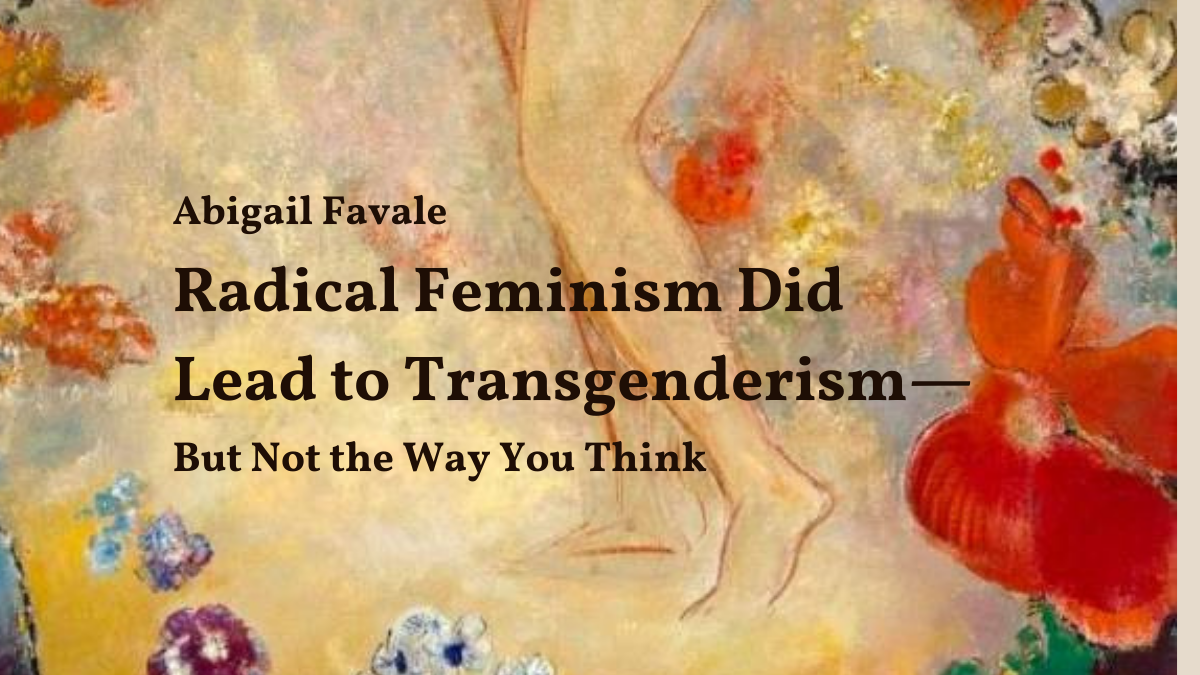I am going to offer a qualified yes to the posed question: did feminism create transgender ideology? I am thus in general agreement with the answer given by Louise Perry—but for different reasons.
Louise argues that feminism unwittingly created the “ideological conditions for transgenderism to take off” by downplaying the reality and importance of psychological sex differences. I would argue the opposite: that the most popular and mainstreamed forms of trans theory rely on an exaggerated and overly binary account of psychological differences between men and women.
The most common empirical argument for trans theory I’ve encountered is the “intersex brain theory,” which basically holds that some individuals with male reproductive anatomy have female-typical brains (and vice versa). This discrepancy, it is claimed, is the cause of their gender dysphoria, which is best treated by feminizing the body to align with the femininized brain. A common variation of this theory appeals to polarized psychological differences in support of cross-sex identification. In other words, a male’s exhibition of traits that our society associates with women means that this person really is a woman. In this way, downplaying sex differences in the brain and the psyche actually undercuts prominent versions of trans theory.
I draw a different line between the two dots of trans theory and feminism. The line I want to trace is the ongoing and escalating displacement of sex as the defining ground of “woman.” There are two interrelated dimensions of this gradual displacement—the conceptual and the technological—and a continual feedback loop between them.
To make my case, I’ll need to define my terms precisely. By “trans ideology,” I mean the theory that being a man or a woman (or both/neither) is determined by an interior sense of gender (i.e. gender identity) rather than sex. And by “feminism,” I am referring to the predominant mode of feminism that emerged from—and allied with—the sexual revolution. To rewrite and affirm the proposition in my own words: trans theory is the Oedipal offspring of post-second wave feminism.
We can retrace this genealogical line back to two feminist foremothers: Margaret Sanger and Simone de Beauvoir. From Sanger, feminism has inherited an antipathy to female fertility and the corresponding technological “solution” of contraception. From de Beauvoir, feminism has inherited the conceptual disconnection of “woman” from “female,” which has become enshrined in feminist theory via the term “gender.”
Let’s look at these twin legacies in turn.
The Technological “Solution”
First, the technological. Early feminists recognized the problem of unwanted pregnancy and sought a solution in the exercise of continence and self-regulation, particularly on the part of men, and social norms that would encourage this. Sanger, however, placed the blame for all social ills—from poverty to tyranny—at the feet of women, namely their ability to get pregnant. (I’m not exaggerating; the scapegoating of female fertility is quite explicit in her writings.)
Rather than seeking a behavioral solution that responded to the reality of female fertility and sexual co-generativity, she proposed a technological solution that would undo that reality: the contraceptive pill. This approach addresses the “problem” of pregnancy by treating female fertility as a sickness rather than a sign of health. The pill works by putting the female body in a state of dysregulation that results in temporary sterility. Now women can have sex without getting pregnant—just like men! While the early feminists sought to better adapt male behavior to the reality of female generativity, contraception does the opposite: adapting the female body to the male norm.
This technological innovation prompted a sea change in social norms and expectations regarding sexuality. I would also argue that it profoundly reshaped our cultural imagination—our implicit understanding—of what differentiates men and women. Prior to contraception, there was a more immediate, instinctive awareness of “man” and “woman” as connected to generative realities: a woman has the potential for motherhood, and a man has the potential for fatherhood. One can even see this understanding reflected in the autobiographical writings of the early transsexual Lili Elbe, who expressed a desire to be a complete woman, which included the potential for motherhood. In our contraceptive culture, we now have a consciousness of assumed sterility, which has shifted the defining ground of “woman” and “man” away from reproductive potential—it’s now about what we look like, what we wear, what we like or dislike, and perhaps most of all, how we are depicted in porn.
Sexual difference has always been expressed in externalities that vary from culture to culture. What has changed in our culture is that those external expressions are no longer understood as signaling an underlying generative reality; they are taken as reality. To approximate an appearance is to be. The significance of generativity in our ambient conceptions of man and woman has all but entirely receded.
Another way of putting this is to say that gender—rather than sex—has become the ground of “woman.”
The Rise of “Gender”
This connects us to the second feminist legacy: the ever-morphing concept of gender.
Feminist philosopher Simone de Beauvoir did not use the term gender, but she formulated the concept that gender would come to name: “One is not born, but rather becomes a woman.” She makes a distinction here between the facticity of biological sex (femaleness) and the cultural elaborations that are layered onto femaleness and often mistakenly read as natural.
This is a helpful distinction to make. What is perhaps less helpful is the subsequent import of the term “gender” to enable that distinction, which has had unanticipated and unhelpful downstream effects. If “female” is to “sex” as “woman” is to “gender,” we’ve entered a schema where “woman” is grounded in “gender” rather than sex. In other words, “woman” is a cultural construct distinct from femaleness. What’s more, “womanhood” is often presented in feminist theory as an oppressive construct that should be dismantled.
This sex/gender split, and the emphasis on gender as a construct, helped bring about the hegemony of social constructionism in feminist thought. This perhaps reached its peak in the influential early work of Judith Butler, who extended the sphere of social constructionism to include the category of sex itself. Pushing de Beauvoir’s initial arguments further, Butler argued that “female” is just as much a construct as “woman” (quote). Sex is likewise a “fictive construction.” To put it another way: sex is gender, too.
Post-Butler, we have, at the heart of feminist theory, the concept of woman as a free-floating artifice and femaleness as a social fiction. There is little ground left here to protest the appropriation of these categories by males.
Reversing the Second-Wave Split
Today’s trans theory, however, does not map easily onto early Butler (which may be why she now distances herself from her early work). Most iterations of trans theory appeal to an inner sense of gender that is taken as innate and unchangeable. Within this framework, gender is decidedly not a mere construct.
In this sense, trans theory is a reversal of the second-wave split between sex and gender: now, sex is the construct, and gender is real. Why, then, am I claiming that one has emerged from the other, if they appear to be opposites?
Despite their differences, Butlerian constructionism and the subjectivism of trans theory share a common foundation: the deconstruction of sex as a stable, identifiable, reproductive reality, and the underlying referent of the terms “man” and “woman.”
Tracing this deconstruction back to its origins, I think we can draw a clear genealogical line between feminism and today’s transgender phenomenon—while acknowledging other progenitors as well, such as the lucrative gender medicine industry, technological advances in body modification, and the curious amalgamation of fandom, porn, and identity politics that brewed in the incubator of Tumblr in the 2010s before going mainstream.
However, the efficacy of these other causal factors depends upon the gradual uprooting of gender from sex—of “woman” from “female”—a disembedding propelled by technological and conceptual changes over the twentieth century that were driven, first and foremost, by second-wave feminism.



